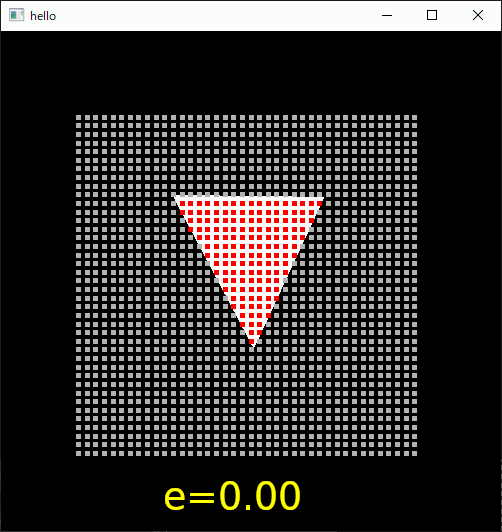スポンサーリンク
二次元の三角形の内外判定で誤差を指定する
二次元の、ある点が三角形の内側にあるか外側にあるかを判定するコードを以前紹介したのだが、点が三角形の境界ぎりぎりにある場合問題を起こすことがある。
判定方法はs,tを計算し、それが0~1に収まっていれば内側と判断するので、この範囲を0.1~0.9などに変更すると誤差を指定することができるようになる。
誤差指定版
//https://suzulang.com/2d-triangle-in-out-check/ template<typename real_t> inline bool isInTheTriangle( real_t px, real_t py, real_t p0x, real_t p0y, real_t p1x, real_t p1y, real_t p2x, real_t p2y ) { real_t Area = 0.5 * (-p1y * p2x + p0y * (-p1x + p2x) + p0x * (p1y - p2y) + p1x * p2y); real_t s = 1.0 / (2.0 * Area) * (p0y * p2x - p0x * p2y + (p2y - p0y) * px + (p0x - p2x) * py); real_t t = 1.0 / (2.0 * Area) * (p0x * p1y - p0y * p1x + (p0y - p1y) * px + (p1x - p0x) * py); real_t e = 0.05; real_t tmin = 0.0 - e; real_t tmax = 1.0 + e; if ( (tmin < s) && (s < tmax) && (tmin < t) && (t < tmax) && (tmin < (1 - s - t)) && ((1 - s - t) < tmax) ) { return true; } else { return false; } }
呼び出し例
auto p0 = glm::vec3(-0.913841, 0.999223, 0); auto p1 = glm::vec3(0.032665, -0.787554, 0); auto p2 = glm::vec3(0.853559, 0.974719, 0); glBegin(GL_TRIANGLES); glVertex2fv(glm::value_ptr(p0)); glVertex2fv(glm::value_ptr(p1)); glVertex2fv(glm::value_ptr(p2)); glEnd(); glPointSize(5); glBegin(GL_POINTS); for (float x = -2.f; x < 2.f; x += 0.1f) { for (float y = -2.f; y < 2.f; y += 0.1f) { bool hit = isInTheTriangle( x, y, p0.x, p0.y, p1.x, p1.y, p2.x, p2.y ); if (hit) glColor3d(1, 0, 0); else glColor3d(0.7, 0.7, 0.7); glVertex2f(x,y); } } glEnd();
この記事のトラックバックURL:


